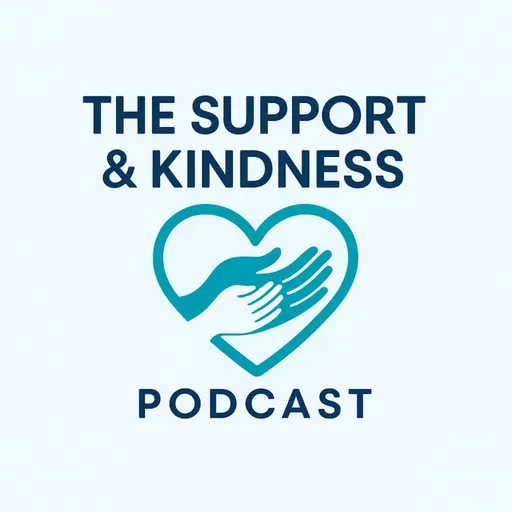
Episode 7: Kindness
Release Date: October 18, 2025
Hosts: Greg and Rich
Episode Summary: In this episode, Greg and Rich explore kindness—what it means, why it matters, and how it impacts mental, physical, and social well-being. They discuss the science behind “helper’s high,” the role of hormones like oxytocin, serotonin, and dopamine, and how kindness lowers stress and supports long-term health. They also connect kindness to leadership, workplace culture, and the ripple effect of small daily actions.
The conversation touches on cultural perspectives—Golden and Silver Rules, Buddhist metta—and emphasizes practicing self-kindness as the foundation for showing kindness to others. Real-life examples include returning grocery carts for parents, praising customer service reps to their supervisors, and simply smiling at strangers—actions that can change someone’s day and, sometimes, save a life.
Key Topics Covered:
Defining kindness: consideration of others’ needs, feelings, and differences
The science of kindness: oxytocin, serotonin, dopamine, endorphins, cortisol
Helper’s high and runner’s high parallels
Physical health benefits: reduced stress, lower blood pressure, stronger immune system, longevity
Workplace impact: innovation, retention, morale, PR, reduced absenteeism and turnover
Leadership and coaching: building self-esteem with simple positive feedback
Cultural lenses on kindness: Golden Rule, Silver Rule, Buddhist metta (loving-kindness)
Self-kindness: “oxygen mask first” approach
Everyday examples: small acts with big ripple effects
Family and community: modeling kindness at home, school, work, and neighborhood
Noteworthy Quotes and Observations:
From Greg:
“Sometimes it’s hard to be nice to someone who’s not nice back—trying to rise above that.”
“They did a thing once… the saddest note they found said, ‘If one person smiles at me on the way, I won’t go through with it.’”
“If you want to help yourself, help someone else.”
Insight: Greg underscores the ripple effect of small acts (smiles, compliments, calling back) and connects kindness to measurable health outcomes (lower cortisol, blood pressure, weight control). He highlights the importance of self-kindness via the airplane oxygen mask analogy and raises the cultural nuance of “treat people the way they would like to be treated.”
From Rich:
“Kindness… gives positive reinforcement to both the giver and the receiver.”
“It’s doing all of the things we mentioned without the expectation of praise or reward.”
“Simple smiles to strangers.”
Insight: Rich brings a research lens (hormone release, immune benefits) and applies kindness to leadership and coaching, emphasizing how small affirmations (a smile, “you did a good job”) can boost self-esteem and performance. He introduces the Silver Rule—avoiding harm—as a practical ethical framework and offers a concrete, repeatable kindness habit: returning grocery carts for parents.
Main Takeaways:
Kindness is both a choice and a practice—small actions create outsized impact.
Biological boost: acts of kindness trigger oxytocin, serotonin, dopamine, and endorphins, while reducing cortisol—supporting mental clarity, stress reduction, cardiovascular health, and immunity.
Helper’s high is real: helping others can produce a euphoric, motivating effect similar to runner’s high.
Be kind to yourself first: self-care enables consistent kindness to others.
Leadership amplifies kindness: positive feedback and recognition improve morale, performance, and retention.
Culture matters: adapt kindness to people’s preferences; consider Golden Rule, Silver Rule, and Buddhist metta.
The ripple effect: a single smile or sincere thank-you can lift multiple people down the line.
Episode Highlights
Definition and framing: kindness as considerate and culturally aware behavior
Neuroscience: oxytocin (bonding, vasodilation), serotonin/dopamine (reward), endorphins (natural pain relief), cortisol reduction (stress relief)
Physical outcomes: lower blood pressure, stronger immune system, potential for longer life
Workplace: happier employees are more innovative; kindness improves PR and profitability
Leadership: simple recognition (“hey, you did a good job”) boosts confidence and performance
Ethical rules: Golden Rule (do good), Silver Rule (avoid harm), plus “treat people how they want to be treated”
Self-kindness: oxygen-mask principle for caregivers and leaders
Practical kindness: returning carts for parents; praising customer service to supervisors; smiling at strangers; thanking callbacks
Family and schools: model kindness and actively teach it to children
Actionable Ideas:
Practice the “two-for-one” praise: thank a helpful rep, then inform their supervisor.
Create a daily kindness cue: one smile, one compliment, one act of service.
Adapt kindness to context: ask how others prefer to be treated.
Build workplace micro-habits: regular recognition, peer shout-outs, no-meeting kindness minutes.
Self-care check: schedule rest, set boundaries, speak to yourself with the same compassion you offer others.
Teach and model kindness: family “kindness challenges,” school projects, neighborhood appreciation notes.
Resources Mentioned:
Concepts: Golden Rule, Silver Rule, Buddhist metta (loving-kindness)
Psychological/physiological terms: oxytocin, serotonin, dopamine, endorphins, cortisol
Cultural note: kindness norms differ by culture—learn before assuming
Call to Action:
Share your stories and ideas: kindnessrx.org
Send topic suggestions for future episodes via kindnessrx.org
For more resources, stories, and to share your own kindness practices, visit https://kindnessrx.org